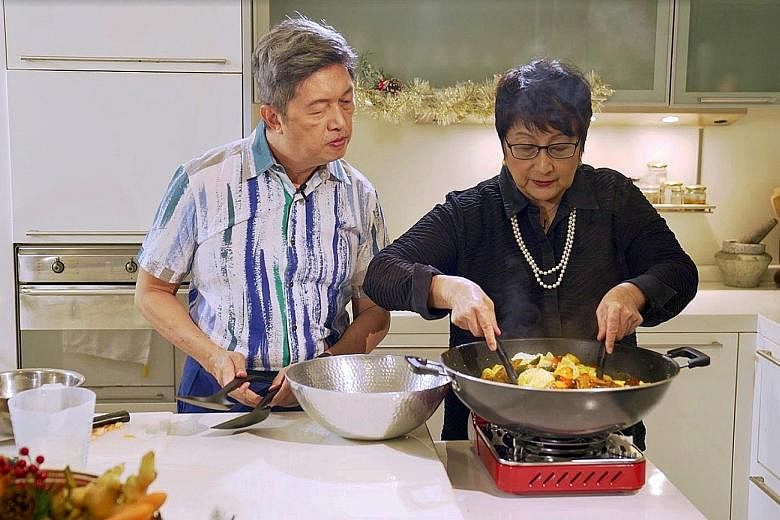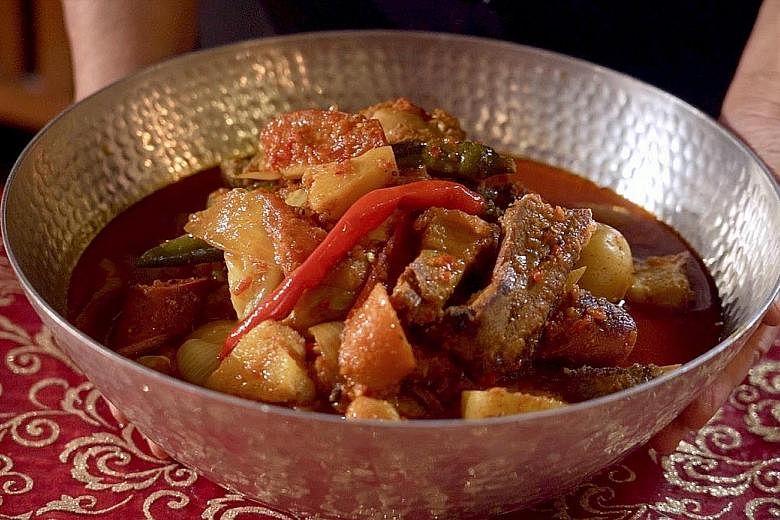CURRY DEVIL Preparation time: Four hours (including soaking time) Cooking time: One hour Serves: Six to eight as part of a Christmas meal
INGREDIENTS
½ (600g) chicken 300g pork spareribs, ready chopped 250g Chinese roast pork with skin 2 Italian sausages or cocktail sausages 1 carrot 1 to 2 large potatoes 2 large onions 2 slices pineapple 3 tomatoes, ripe 6 fresh red chillies 6 fresh green chillies ¼ cabbage 4 to 6 Tbs olive oil ½ to ¾ cup vegetable oil
METHOD
1. Cut the chicken into eight to 10 pieces and buy the pork ribs ready chopped into finger lengths. Cut the Chinese roast pork into bite-sized pieces and the sausages into thumb lengths. Peel the carrots, potatoes and onions and cut into wedges. 2. Cut each pineapple slice into four to seven pieces and cut each tomato into six wedges. Pluck or cut off the stalks of the chillies and cut each chilli into half along the length only halfway through. Cut the cabbage into large chunks.
SEASONING FOR CHICKEN AND PORK RIBS
2 tsp of each - dark soya sauce, light soya sauce, pepper powder and lime juice for each type of meat.
SPICE MIX TO POUND OR GRIND INTO A SEMI-FINE PASTE
10 fresh red chillies 10 dried chillies 50g ginger 1 thumb fresh turmeric root 3 large onions 1 ½ tsp mustard seeds (biji sawi)
METHOD FOR SPICE MIX
1. Cut chillies roughly, soak dried chillies in boiling water for one to two hours till soft, drain. Peel ginger and turmeric root and peel and cut onions into chunks. 2. Grind or pound all spice mix ingredients together into a semi-fine paste.
SAUCE
6 Tbs white vinegar 6 Tbs tomato ketchup 3 to 5 Tbs sugar 1 ½ Tbs Coleman's mustard powder 2 tsp prepared English mustard 2 tsp dark soya sauce 1 ½ to 2 tsp salt 2 to 4 cups water
METHOD FOR SAUCE
Mix all the ingredients and use only two cups of water to mix into the sauce - add more water while cooking. Adjust during cooking to your own taste. I love an intense sweet, sour and hot flavour, but many people like their savoury food less sweet.
TO COOK
1. Turn oven to 180 deg C. 2. Season the chicken and pork ribs for 15 minutes. Toss in one to two tablespoons of olive oil. 3. Toss the sausages, potatoes, carrots and pineapples in about one to two tablespoons of olive oil in a bowl. This provides a thin oil coating. 4. Roast the pork ribs in the oven for 15 minutes. You roast the pork ribs first because the pork takes longer to cook. 5. Add the chicken, sausages, potatoes, carrots and pineapples and roast for 15 minutes. 6. Remove from the oven. This simulates ready-cooked leftover food and this pre-roasting gives the dish its extra kick. 7. Heat the oil in a wok and fry spice mix till fragrant, for about eight to 10 minutes, till oil starts exuding. 8. Add the onions, tomatoes, whole chillies, pork ribs and roasted pork. Stir-fry briefly, then add the sauce ingredients and one cup of water. 9. Bring to the boil on high heat, then turn down heat to simmer for 15 minutes till the pork is semi-tender. 10. Add the pineapple, chicken, sausages, carrots and potatoes and simmer for 10 to 15 minutes till the half-cooked roasted chicken is cooked. Boil for up to 30 minutes. Test for doneness of the pork and chicken. 11. Add more water if the gravy becomes too thick. Spread the cabbage on top and cover with a lid. 12. Steam the cabbage over the stew for two to three minutes till the cabbage changes colour but is still crispy. 13. Switch off heat, stir well and serve with chunks of baguette and a salad.
It is the happy holiday of Christmas next week and we celebrate in traditional Singapore style with the Eurasian Curry Devil, also known as Devil's Curry and Curry Debal in the Kristang language.
I have many happy memories of friendship and kinship with the Eurasians of Katong, that special eastern shore of Singapore which is also the heartland of Peranakan culture. Both cultures share food traditions and, for many, a common Catholic religion.
The Eurasians of Singapore, though originally from Melaka with their Portuguese-Malay origins, quickly embraced the cultures and traditions of new cultures through inter-marriages between Asians and Europeans - all of which contribute to the rich tapestry of Eurasian life in Singapore.
One uniquely Eurasian dish is Curry Devil, also known as Curry Debal, originally created from the leftovers of the Christmas roast of turkey or a large chicken.
That Christmas meal would typically include vegetables, sausages, Chinese roast belly of pork and even sometimes Chinese sausages called lapcheong.
The whole lot was put into a pot and emerged as a special dish enriched with spices and sauces.
Today, this dish of "leftovers" is often the main star of the Christmas meal in many Eurasian households.
For me, as for Straits Times Senior Food Correspondent Wong Ah Yoke, my co-host this week, this dish of Curry Devil evokes happy memories of family and friendship.
Ah Yoke remembers arriving in Singapore from Kuala Lumpur at 20 to study at the National University of Singapore and it was the invitation to a Eurasian home and the first taste of Curry Devil that made him feel welcome.
Many believe the name "devil" alludes to the red-hot chilli taste that burns your mouth - love at first taste.
My father's sister, my gee koh Nancy, introduced me to her very good Eurasian friend's recipe for Curry Devil.
I remember the embarrassment of riches in the dish - chicken, pork ribs, sausages, Chinese roast pork, lapcheong - the combination spelt taste and texture magic.
This dish features in my first editor David Kraal's cookbook of Eurasian family dishes, Treasures.
This time of year, we celebrate the treasures of life.
It has been a tough two years. Yet, after the intense fear of the unknown when Covid-19 first reared its ugly head last year, we have survived, many have thrived and many more have located an inner resilience and strength which has stood them in good stead.
Let us celebrate and wish one another good cheer.
Violet Oon's Life in Food For me, as for Straits Times Senior Food Correspondent Wong Ah Yoke, my co-host this week, this dish of Curry Devil evokes happy memories of family and friendship.
''


